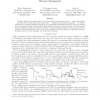Free Online Productivity Tools
i2Speak
i2Symbol
i2OCR
iTex2Img
iWeb2Print
iWeb2Shot
i2Type
iPdf2Split
iPdf2Merge
i2Bopomofo
i2Arabic
i2Style
i2Image
i2PDF
iLatex2Rtf
Sci2ools
94
Voted
ISORC
2005
IEEE
2005
IEEE
On Recent Advances in Time/Utility Function Real-Time Scheduling and Resource Management
We argue that the key underpinning of the current state-of-the real-time practice — the priority artifact — and that of the current state-of-the real-time art — deadline-based timeliness optimality — are entirely inadequate for specifying timeliness objectives, for reasoning about timeliness behavior, and for performing resource management that can dependably satisfy timeliness objectives in many dynamic real-time systems. We argue that time/utility functions and the utility accrual scheduling paradigm provide a more generalized, adaptive, and flexible approach. Recent research in the utility accrual paradigm have significantly advanced the state-of-the-art of that paradigm. We survey these advances.
Deadline-based Timeliness Optimality | ISORC 2005 | Software Engineering | State-of-the Real-time Practice | Timeliness Objectives |
| Added | 25 Jun 2010 |
| Updated | 25 Jun 2010 |
| Type | Conference |
| Year | 2005 |
| Where | ISORC |
| Authors | Binoy Ravindran, E. Douglas Jensen, Peng Li |
Comments (0)

